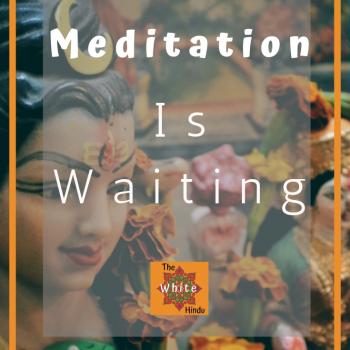Over the last several years we’ve all heard so much about meditation and its benefits. How it reduces stress, brings peace into our lives, helps with medical conditions, not to even mention the spiritual side of it. Yet I am not alone in putting it off like a distasteful part of my to-do list.
The Boston Globe just had an article about people who want to meditate but haven’t gotten around to it. And the stress that not doing something we feel like we should do creates!
Unfortunately I can’t link to the article since it’s for Boston Globe subscribers only, but I can speak from my own experience.
For me part of the struggle is that word “should.” It makes meditation take the same place in my mind as flossing my teeth and eating five servings of veggies a day. Ugh. Yet, when I’m actually doing it, I feel great!
It’s hard in our hectic modern life to find twenty or thirty minutes to do this. There’s Facebook to check, friends to call, snuggling on the couch with a spouse to do. So here’s what we’re going to do: we are going to start with just ONE MINUTE per day. And we’ll build up from there. Just for this week.
Simple enough, right?
I want you to join me. Today I am going to meditate for just one minute. Tuesday I am going to meditate for two minutes. Wednesday I am going to mediate for three minutes. Thursday I am going to meditate for four minutes. Friday I am going to meditate for five minutes. That’s it.
I am going to try attaching this to one of my other habits, like doing it right after brushing my teeth in the morning, maybe.
I will post on Twitter and Facebook when I do mine and I want you to reply in either place (or here) and tell me that you did yours!
***
What kind of meditation should you do? There are a bunch of different options. Pick from one of these…
Mantra Meditation
Select a word of phrase that reflects for you the feelings you want to have such as:
- Peace
- All is good
- Om
- Om Namah Shivaya (I bow to Shiva)
- Any kind of affirmational phrase
Sit still with your back straight and close your eyes. Repeat the word or phrase over and over. Don’t think about what it means. Repeat it as quickly or slowly as you like. If you start thinking about something, notice it happening and bring your attention back to your mantra.
Mindfulness Meditation
You can do this one either sitting or walking. Allow yourself to become aware of your senses. Without thinking about what you are seeing, smelling, hearing, or feeling, become aware of all the sensory input that is surrounding you. Let yourself soak in it. Focus your attention on the sensations of your body. Pay attention to your breath as it naturally flows in and out of your body. Observe the sensations of your body, the sounds and feels around you. Allow yourself to just be. As thoughts flit across your mind, just watch them without engaging in them.
Guided Meditation
There are countless guided meditations to be found on YouTube. Of course there are also classes that you could take for this, but for now sit in front of your computer and pick the one you want and make it full screen. It will give you instructions. Sometimes you are meant to close your eyes, other times to watch the visuals. These are often closely related to hypnosis.
Here are a couple you could try (if you want to stick to the one minute, two minute, etc. guidelines, pick a video that is as close to that length as you can. Better not to disrupt yourself in the middle of these longer guided meditations):
http://www.youtube.com/watch?v=sJO15eCQaqABreath Awareness
Instructions from MeditationOasis.com…
Sit comfortably and close your eyes. Take a few moments to “simply be”. Notice whatever is being experienced in the moment — sounds, physical sensations, thoughts, feelings — without trying to do anything about it. Continue like this a little while, allowing yourself to settle down.
Now bring the attention to the breath. Simply notice the breath as it moves in and out as the body inhales and exhales. Notice how the breath moves in and out automatically, effortlessly. Don’t try to manipulate it in any way. Notice all the details of the experience of breathing — the feeling of the air moving in and out of the nose, the way the body moves as it breathes, etc.
The mind will wander away from the breath — that’s fine, it doesn’t matter. That’s a part of the meditation! When you notice that you are no longer observing the breath, easily bring your attention back to it.
Let all of your experiences — thoughts, emotions, bodily sensations — come and go in the background of your awareness of the breath. Notice how all of your experiences — thoughts, emotions, bodily sensations, awareness of sounds and smells — come automatically and effortlessly like the breath.
…When you are settled into the process of observing the breath, become aware of the point at which the breath turns the corner from the inhalation to the exhalation, and from the exhalation to the inhalation. Notice what is there. It is not a thing — it is a gap between the breaths, nevertheless there can be awareness of it. It is a kind of “still point”.
Continue to bring your attention to that still point, bringing your attention back to the gaps in the breath whenever it has wandered away. As you continue practicing this meditation, you may find that the stillness is no longer experienced as discrete gaps between the breaths, but is a more continuous experience. This cultivates the awareness of the stillness that is present in the midst of activity, and can create a profound experience of peace.
Mandala Meditation
This meditation uses beautiful pictures to focus the mind. For some people a visual focus is easier to meditate on than a sound or a word in the mind. All you need to do is look at the mandala without staring and without thinking about it. If you start to daydream, bring your attention back to the image. If your eyes tire, allow them to close and keep picturing the mandala in your mind. Once you’ve rested a little, open your eyes to keep looking at it.
Here are some mandalas you could use. Pick one and make it as full screen as you can or print it out (I find that meditation is better away from electronics!)
***
An article about the distinctions between meditation, mindfulness, and mindfulness meditation:
So the intention of Basic Meditation is to trick the mind into releasing itself, trick the mind into giving the thinking apparatus a rest, so that we can realize our Higher Selves, our essential oneness with whatever we consider to be divine. On the other hand, the intention of Mindfulness Meditation is secular; namely, to train the mind, in the same way that we would lift weights to strengthen a muscle, to be able to concentrate — and avoid weakly wandering around on autopilot — for longer and longer periods of time.
This week is meditation week, check out the rest of the posts:
What Gurus Say About Meditation

















